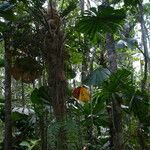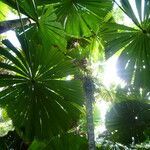A slender palm. The trunk can be 18 m tall. The trunk can be 10-20 cm across. The leaves of young plants have a few widely spaced segments. In mature plants the leaves are almost circular with crowded segments. The leaf blades may be 2 m across. The leaf stalk is 1.5-2 m long by 3-4 cm wide. They are slender and arching and spiny at the base. The flowers occur on panicles which hang down from among the leaves. The flowers are white. The fruit are brilliant orange-red. They are 1 cm across.



